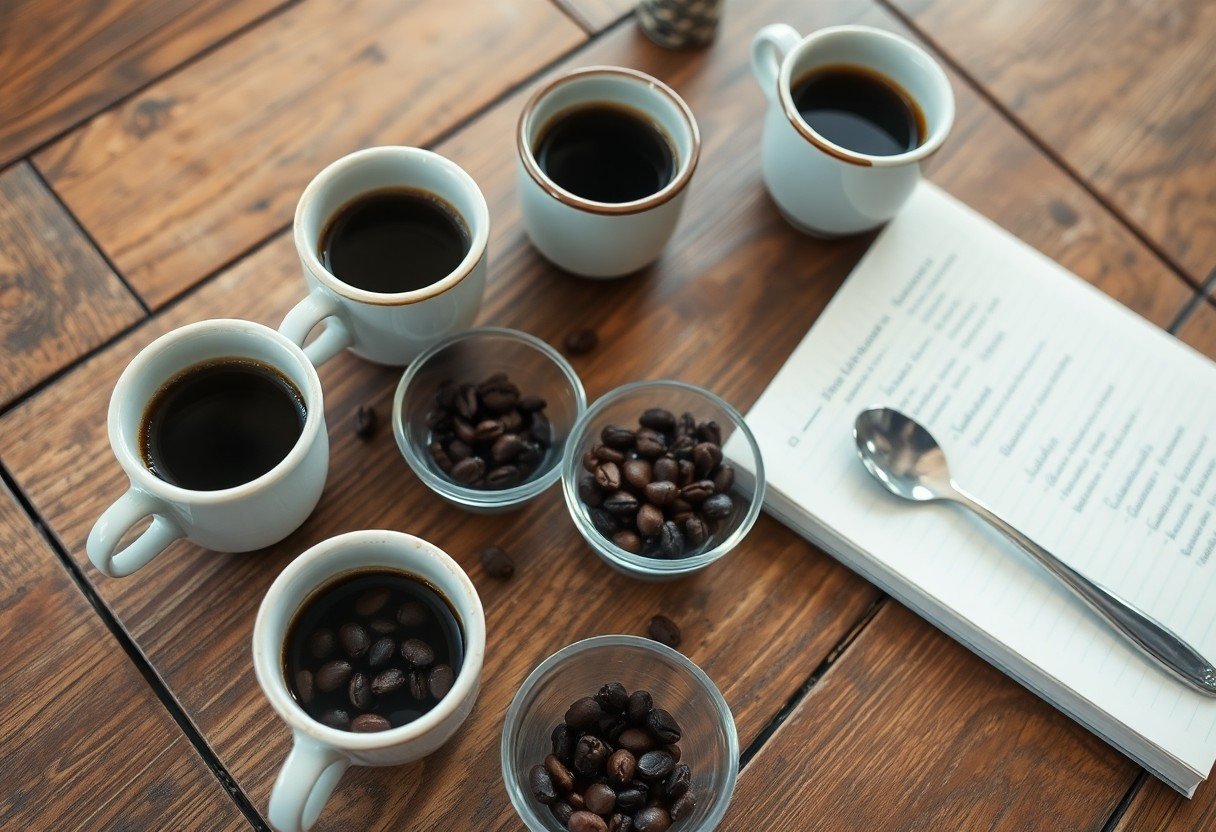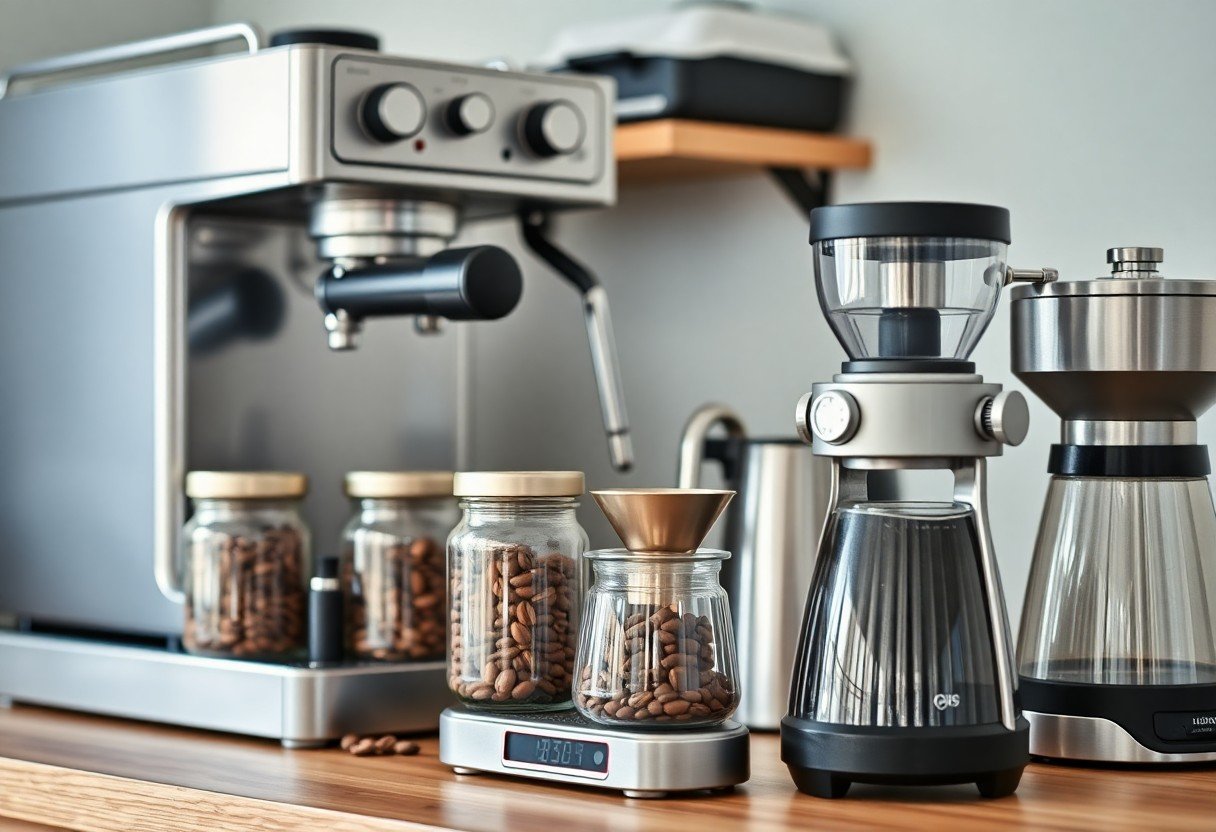Mastery of bold artisan coffee flavor profiles can transform your home brewing experience, elevating your daily cup to new heights. You’ll discover how to select the right beans, utilize proper brewing techniques, and experiment with various methods to enhance the rich array of flavors. With the right approach, your home brews will rival those from the finest coffee shops. Dive in to learn how you can awaken your taste buds and create exceptional coffee every time.

The Art of Coffee Sourcing: Cultivating Flavor Diversity
Your journey into bold artisan coffee begins with sourcing the right beans. Cultivating flavor diversity requires you to explore different regions, processing methods, and farmer partnerships. The microclimates and agricultural practices vastly influence the flavor characteristics of coffee, allowing you to discover unique profiles that elevate your brewing experience.
Terroir: How Location Influences Flavor
Location impacts coffee flavor through unique soil compositions, climate conditions, and altitude. For instance, Ethiopian coffee often exhibits bright acidity and fruity notes due to its high elevation and diverse microclimates. In contrast, beans from Brazil tend to be lower in acidity and feature chocolatey, nutty flavors, shaped by the country’s warm, stable climate.
Bean Varieties: A Tapestry of Taste
The diversity of coffee bean varieties is akin to a tapestry woven from distinct threads, each adding its unique taste and aroma. Varieties like Arabica, with its nuanced flavors, and Robusta, known for its boldness, represent just a fraction of the spectrum. Within Arabica, you’ll find sub-varieties such as Geisha, famous for its floral notes, and Bourbon, celebrated for its sweetness, each inviting exploration and experimentation in your brewing routine.
Delving deeper into bean varieties reveals a world rich with flavor profiles. For example, Yirgacheffe, a subtype of Arabica, often exhibits hints of jasmine and tropical fruits, making it a favorite among flavor enthusiasts. On the other hand, Gesha from Panama is renowned for its complexity, often showcasing notes of bergamot and tea-like qualities. By selecting specific varieties based on desired flavor profiles, you can create a coffee experience that is not only bold but also uniquely personal to your palate.
The Roast Spectrum: Unlocking Unique Profiles
The roast spectrum significantly influences the flavor profile of your coffee, with light, medium, and dark roasts each bringing unique characteristics to your cup. Light roasts tend to showcase the delicate nuances of the coffee bean itself, including acidity and floral notes, while dark roasts deliver robust, smoky flavors often accompanied by a fuller body. Understanding this spectrum allows you to choose roasts that align with your taste preferences and brewing methods, creating a personalized coffee experience.
Light Roasts vs. Dark Roasts: The Flavor Tug-of-War
Light roasts highlight the inherent qualities of the beans, offering bright acidity and fruity undertones, while dark roasts provide a rich, bold flavor with a bittersweet finish. This tug-of-war between the origin notes of lighter profiles and the roasting depth of darker profiles defines your coffee journey. You might prefer the crisp brightness of a light roast one day, only to find yourself craving the warmth and depth of a dark roast the next.
Profiles of Popular Roasts: Full-bodied, Fruity, and Beyond
Exploring popular roast profiles reveals a diverse range of tastes, from full-bodied and earthy to bright and fruity. Medium roasts often provide a balanced flavor with hints of chocolate and caramel, while light roasts can evoke notes of citrus and berries. Dark roasts tend to bring forth heavier, smoky flavors complemented by a syrupy mouthfeel. Each profile offers distinct attributes that will elevate your brewing experience.
For instance, a full-bodied roast, such as a Sumatra, can deliver earthy undertones with hints of chocolate, ideal for those who enjoy a rich, smooth experience. On the other hand, a light roast like an Ethiopian Yirgacheffe might surprise you with vibrant floral notes and a tea-like brightness. Understanding these profiles helps you select beans that cater specifically to your palate, making each brewing session a delightful exploration of flavor.
Brewing Techniques that Transform
Mastering brewing techniques unlocks the potential of your coffee, allowing you to fine-tune flavors to match your palate. Each method engages with the coffee grounds uniquely, enhancing specific notes while subduing others. For instance, variations in water temperature, brewing time, and even agitation can dramatically affect extraction, leading to a vibrant cup that reflects your specific preferences and the bean’s unique characteristics.
The Impact of Grind Size on Flavor Extraction
Grind size plays a pivotal role in flavor extraction, influencing both the strength and clarity of your brew. Finer grinds increase surface area, leading to more rapid extraction, which can intensify flavors but risk over-extraction. Conversely, coarser grinds allow for a slower extraction, yielding a gentler, less pronounced cup. Finding the right grind size often requires experimentation, as it will vary based on your brewing method and intended flavor profile.
Brewing Methods: From Pour Over to French Press
Variations in brewing methods significantly shape the flavor experience you encounter in each cup. Different techniques emphasize distinct characteristics of the coffee; for example, pour-over allows you to control water flow, enhancing brightness and acidity, while French press offers full-bodied richness by immersing coffee grounds for a prolonged period. Each method has unique parameters, such as brew time and water temperature, that significantly impact the final result.
The pour-over method, known for its clean and delicate flavors, produces a cup that highlights the coffee’s acidity and subtle tasting notes. Using a gooseneck kettle allows for precise pouring control, facilitating an even saturation of the grounds. In contrast, the French press delivers a robust and full-bodied experience, as the immersion brewing method extracts oils and sediments that contribute to a denser mouthfeel. Experimenting with variations like Aeropress or siphon brewing can also yield fascinating results, making it important to explore each technique to discover your ideal flavor profile.
Mastering Flavor Pairings: Elevating Your Brew
Flavor pairings can drastically enhance your coffee experience, allowing you to appreciate the depth and complexity of your brew. By understanding your coffee’s unique notes, you can strategically select foods that not only complement but also elevate your drink, creating a well-rounded tasting journey that excites your palate.
Complementary Foods: Building Flavor Bridges
Selecting the right foods to accompany your coffee can create flavor bridges that amplify your tasting notes. Chocolate pairs beautifully with rich, dark roasts, while fruity pastries harmonize with coffee that exhibits bright acidity. Consider a caramelized banana loaf with a medium roast to enhance your brew’s sweetness, creating an inviting combination that delights the senses.
Seasonal Flavors: Tailoring Brew to Occasion
Tailoring your coffee to seasonal flavors can transform your brewing experience. Embrace the warming spices of fall with a cinnamon-infused brew or highlight fresh berry notes in summer with a light roast topped with a splash of cold brew. Using seasonal ingredients captures the essence of each time of year, making each cup a reflection of the moment.
For instance, in winter, consider brewing a spiced coffee blend infused with nutmeg and cloves, creating a cozy atmosphere. During spring, a light roast with floral undertones pairs well with bright, fresh ingredients like lemon and lavender for a refreshing taste. Experimenting with seasonal flavors not only makes your coffee special but also allows you to connect your brew with the moods and flavors of the world around you, enhancing your overall experience.

The Home Barista’s Toolkit: Essential Gear & Ingredients
Your brewing experience hinges on the right equipment and ingredients, elevating your coffee to remarkable heights. A quality grinder ensures a consistent grind size tailored to your brewing method. An accurate scale allows for precise measurement, which is vital for achieving the perfect brew ratio. Invest in a reliable coffee maker, whether it’s a pour-over, espresso machine, or French press, and don’t overlook accessories like a kettle with temperature control or a milk frother for lattes. Finally, keep your tools clean and well-maintained to preserve flavor integrity.
Must-Have Equipment for Optimal Brewing
Sourcing Superior Beans: Navigating the Marketplace
Finding high-quality coffee beans is fundamental to your home brewing success. Explore local roasters who often provide freshly roasted beans with unique flavor profiles. Engage in farmers’ markets or specialty coffee shops to taste offerings before purchasing. Online directories and websites also specialize in artisan coffee, allowing you to filter by origin, roast date, and flavor notes to match your palate.
While shopping for beans, be aware of harvest seasons and preferred origins, as they can significantly impact flavor. For example, Ethiopian coffees are renowned for their fruity and floral notes, while Colombian beans typically showcase a balanced profile with nutty undertones. Look for transparency in sourcing; many roasters share the journey of their beans, from farm to cup. Always check roast dates to ensure freshness, aiming for beans roasted no more than two weeks prior to your purchase for optimal flavor. This diligence in selection sets the stage for your artisan coffee journey.
Summing up
From above, you now possess the knowledge to elevate your home brewing experience by mastering bold artisan coffee flavor profiles. By selecting high-quality beans, experimenting with grind sizes, and optimizing brewing techniques like water temperature and steeping time, you can unlock a world of rich flavors and aromas. Pay attention to your personal taste preferences and adjust variables accordingly to achieve the perfect cup that resonates with your palate. Embrace the journey of exploration and refinement, and you’ll transform your home brewing into a delightful craft.
FAQ
Q: What are the key flavor profiles in bold artisan coffee?
A: Key flavor profiles include chocolate, nutty, fruity, spicy, and floral notes. Each profile can vary depending on the coffee bean origin, roasting method, and brewing technique.
Q: How can I select the right beans for bold flavors?
A: Look for beans labeled as dark roast or specifically showcasing bold flavor notes. Single-origin coffees often have distinct profiles influenced by their growing conditions.
Q: What brewing methods enhance bold artisan flavors?
A: Methods like French press, AeroPress, and espresso tend to extract bold flavors effectively. These techniques allow for fuller extraction and richer cups.
Q: How does grind size affect the flavor profile in brewing?
A: Grind size impacts extraction time; a coarser grind generally results in milder flavors, while a finer grind can enhance boldness due to faster extraction. Adjust according to your brewing method.
Q: What water temperature is ideal for brewing bold flavors?
A: The ideal water temperature for brewing bold coffee is between 195°F to 205°F (90°C to 96°C). This range helps extract the rich flavors without causing bitterness.

